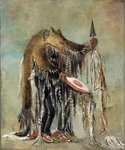



I am a skeptic, a journalist and political scientist by training. Imagine my surprise at being energetically “grabbed” by an announcement for La Escuela de Curanderismo one early morning while catching up on emails, having just returned from Oaxaca the night before. I had a visceral response to a voice saying, “Pay attention! You will do this!”
Upon my graduation nearly a year later, my beloved Escuela teacher and Shamanic practitioner Virginia Nañez, called me out as the most skeptical student to fully embrace these ancient healing arts. This personal transformation occurred only as a result of direct experience, not simple belief. Nearly four years later, I am now midway through a three-year shamanic studies program of the Foundation for Shamanic Studies (FSS), a non-profit organization founded by the legendary anthropologist Michael Harner, who is largely credited with the revival of Shamanism with his 1980 book, The Way of the Shaman.
Shamanism is the original spirituality, so it’s really no surprise that more and more people are “being called” or, more correctly, “called back” to this ancient system of healing and wellness, which recognizes the truth of who we are: spiritual beings of energy and light having a human experience, each of us connected as one with all of creation. Shamanism offers useful tools for healing both the individual and the collective and is the best hope for restoring balance on the planet.
Evidence of Shamanic practice dates back 60,000 years or more. Native Americans have practiced Shamanism for millennia and understood their role as stewards of the Earth. And though indigenous peoples throughout the continent developed sophisticated architecture, were skilled mathematicians and astrologers, their stories and medicinal teachings were transmitted orally, from generation to generation.
Their rich spiritual traditions were largely ignored by early scholars in favor of Judaism, Buddhism and Christianity, which were recorded in writing.
These indigenous cultures of both North and South America were one with all of their relations and understood that their very survival depended upon a harmonious relationship with the natural world. Their decimation and slaughter for land and other natural resources paved the way for the missionaries whose God was without, not within, and only accessible through the patriarchal hierarchy of the church.
The earth-centered, feminine way of spirituality – the belief that every person can have a direct experience of God, and that people can speak to the plants, the animals and the waters - went into hiding. It wasn’t until anthropologists like Harner began studying these ancient peoples and gaining a deep appreciation and respect for their beliefs and traditions, that this ancient spirituality was revived.
Modern-day Shamanism refers to the adaptation and application of ancient healing techniques to address the many challenges of contemporary life. FSS teaches “core Shamanism” – shamanic techniques common to shamans all over the planet. Thus, Harner’s life work offers a pathway for reclaiming one’s own original spirituality and wisdom teachings, while respecting cultural sovereignty.
As spiritual beings experiencing this human life, no one escapes emotional wounding or trauma, yet each of us has the opportunity to shift our perspective and view these challenges as opportunities to heal, grow and evolve our souls.
Shamanic healing practices support this process in part by rebalancing our energetic bodies, restoring the body’s innate ability to heal itself.
The physical body is surrounded by an energetic field or light. Jesus Christ, various Catholic saints, La Virgen de Guadalupe and others are often depicted with this crown of light or aura around them.
As energy beings, we are always being impacted by the energy that surrounds us. Throughout our lives this aura absorbs energies from daily life experience, causing it to become imbalanced and sluggish, leading to disharmony and dis-ease as the energies are introduced into the body via the seven chakras, or energy centers.
A practitioner is often called to clear and rebalance the energetic body, to remove liquid or crystalized energies, or even unwanted entities or attachments. Yes, otherworldly entities exist that can attach themselves to a person’s energetic body, especially when that person is in a weakened state, due to trauma, addiction or other factors.
Sometimes these entities are spirits of the dead who’ve not been able to move on from this physical world. Many Shamanic practitioners become skilled at psychopomp work, which is the ability to guide spirits to where they need to go in the afterlife.
Shamans understand that there is much more to reality than meets the eye; that there exists a world beyond the physical, which is as real or more so than the world of form and matter. They refer to this world as non-ordinary reality or the world of spirit.
Among ancient Shamanic cultures, the most common way of accessing non-ordinary reality is by sonic driving – rhythmic drumming or rattling used to shift brain waves to theta waves, altering consciousness. This trance-like state allows the practitioner to temporarily leave the physical world and journey to non-ordinary reality to retrieve information for healing and divination.
Journeying is the foundation of Shamanic practice and is commonly taught in workshops throughout the world. Practitioners journey initially for themselves, then increasingly on behalf of others as their relationship and trust deepens with their spirit guides.
People who seek Shamanic healing do so for help with common, everyday issues, both painful and joyful.
Shamanic practitioners may create sacred ceremony and ritual for the blessing of marriages or births, or provide support and healing of generational trauma, sexual violence, divorce, dysfunctional relationships, financial issues or chronic illness.
Shamans comfort the sick and dying and are often called to assist when a person is preparing to transition from this physical plane to the realm of spirit. In a process called recapitulation, the shaman helps the dying person make peace with his or herself and loved ones, allowing them to die consciously and peacefully, unburdened by unfinished business.
At its core, Shamanism is really a way of life; a spiritual path that helps the sincere practitioner reconnect to their own inner wisdom, recognizing the divine in all things and living life with greater compassion, joy and love.
These sacred wisdom teachings offer a well-traveled path forward in these challenging times, helping us to live from the heart, with acceptance, non-judgement, non-suffering and beauty.
Lisa Jimenez is a freelance writer and teacher, and a practitioner of Shamanic healing arts and Reiki. For more information, contact her at lmjimenez13@gmail.com.